

James Wong
2025 Mazda CX-5 G25 Touring AWD review
5 Days Ago
If you’re the type of SUV buyer who wants to actually go off-road or do some towing, the Pajero Sport is one of the best value options at this price point.
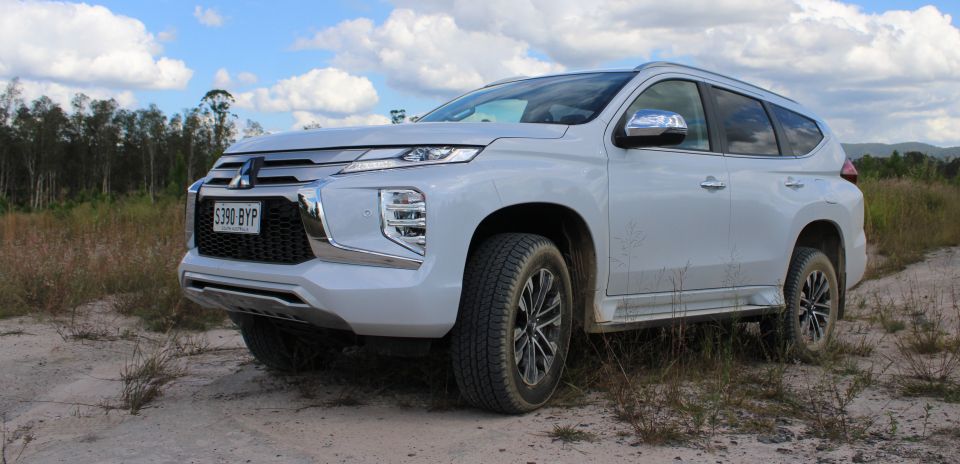
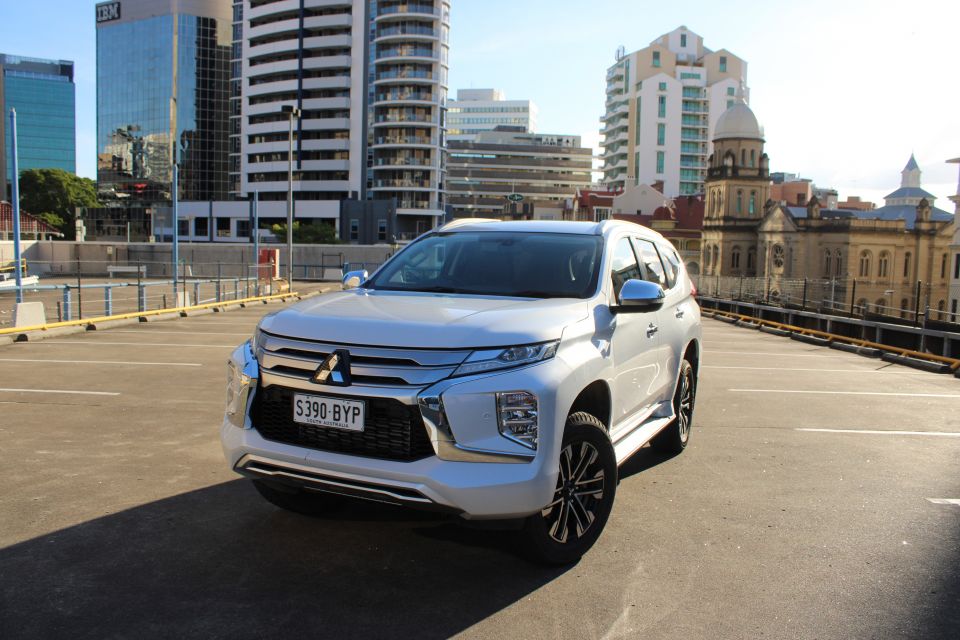

News Editor
New from
$46,490
excl. on-roads

News Editor
New from
$46,490
excl. on-roads


News Editor
New from
$46,490
excl. on-roads

News Editor
New from
$46,490
excl. on-roads
Quickly see how this car stacks up against its competition. Select any benchmark to see more details.
Where expert car reviews meet expert car buying – CarExpert gives you trusted advice, personalised service and real savings on your next new car.
If you want a large, three-row SUV under $60,000, you’ve got two different types of SUV to choose from.
There are car-based crossovers, like the Hyundai Santa Fe and Toyota Kluger, which offer comfortable on-road dynamics but little off-road talent, if any.
Alternatively, there are ute-based SUVs that are much better in the rough stuff.
The Mitsubishi Pajero Sport falls in this second category, along with SUVs like the Ford Everest, Isuzu MU-X and Toyota Fortuner.
So far this year, the Pajero Sport, Everest and MU-X are all selling in identical numbers and far exceeding those of any other ute-based, three-row SUVs, though they all live in the shadow of the rugged Toyota LandCruiser Prado.
This trio of ute-based SUVs are selling about as well as crossover SUVs like the Hyundai Santa Fe and Mazda CX-9, though again a Toyota – the Kluger – outpaces those cars.
Therefore there’s a clear dichotomy between what buyers at this price point prefer. Can a Pajero Sport offer both the off-road ability expected of a ute-based SUV and the on-road refinement expected of a crossover?

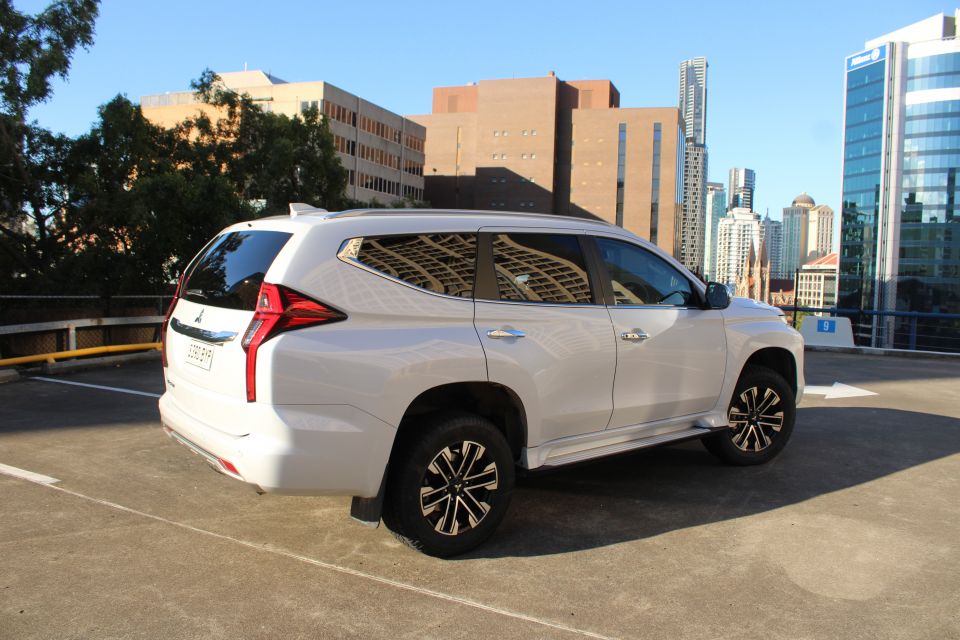
The cheapest seven-seat Pajero Sport is the mid-range GLS at $52,490 before on-road costs.
The range-topping Exceed costs $57,190 before on-road costs and is available exclusively with three rows of seating.
That puts it roughly in the middle of the Mazda CX-9 range, price-wise, while undercutting the range-topping Kia Sorento GT-Line and Hyundai Santa Fe Highlander diesels by between $2000 and $3000.
It compares even better against rival ute-based SUVs. For $57,000, the only 4WD Ford Everest you can get is the base Ambiente.
The range-topping Isuzu MU-X LS-T costs a few hundred more and is on the cusp of being replaced, while the flagship Toyota Fortuner Crusade is $1000 more.
Non-metallic white paint is standard, with metallic point a $740 option. The sole exception is White Diamond, a pearlescent white paint that costs $940.
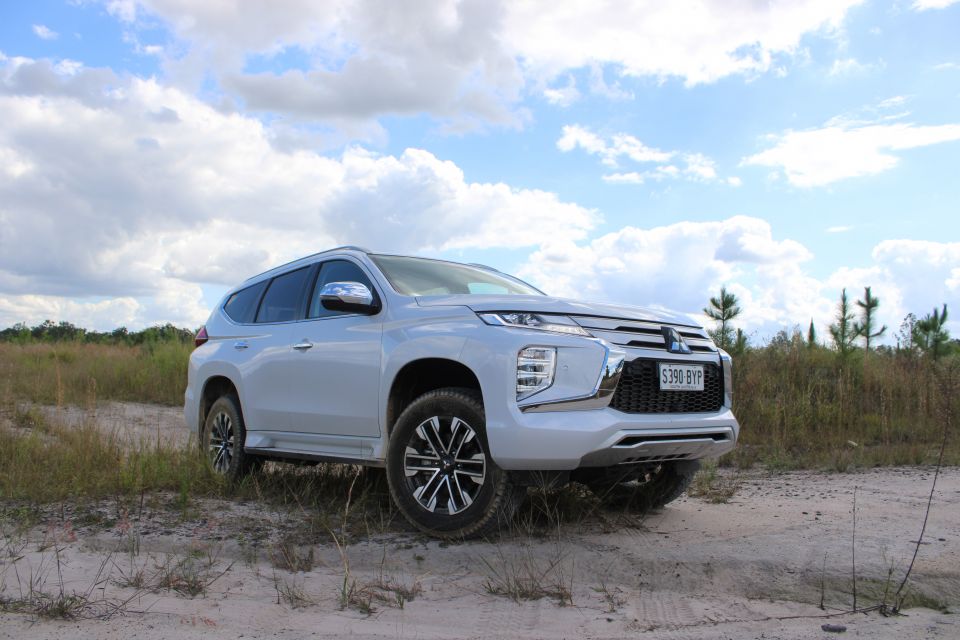
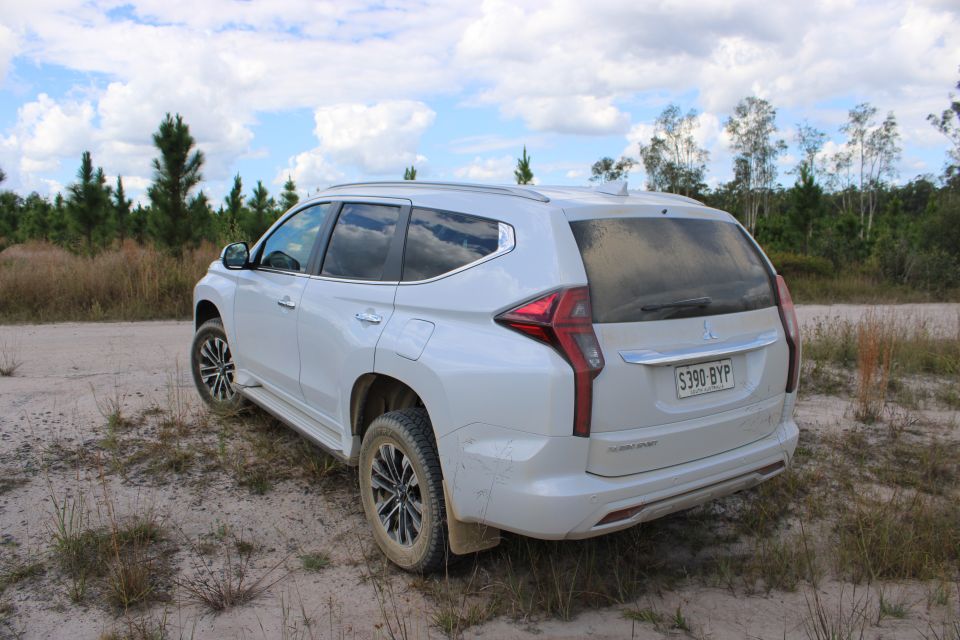
All Pajero Sport models come with an 8.0-inch touchscreen infotainment system with Apple CarPlay, Android Auto, and DAB digital radio, though only the Exceed adds satellite navigation.
Standard equipment includes proximity entry with push-button start, adaptive cruise control, automatic headlights, rain-sensing wipers, dual-zone climate control and a power tailgate.
Notably, these are all standard in the GLS one rung down.
18-inch alloy wheels are also standard across the range so your neighbours mightn’t notice if you go for a GLX or GLS instead.
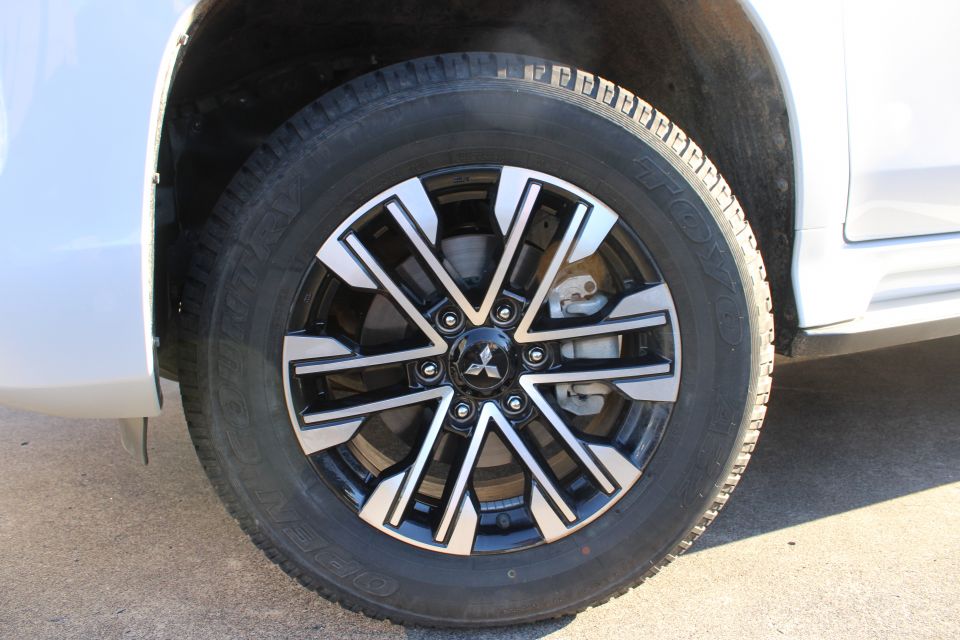

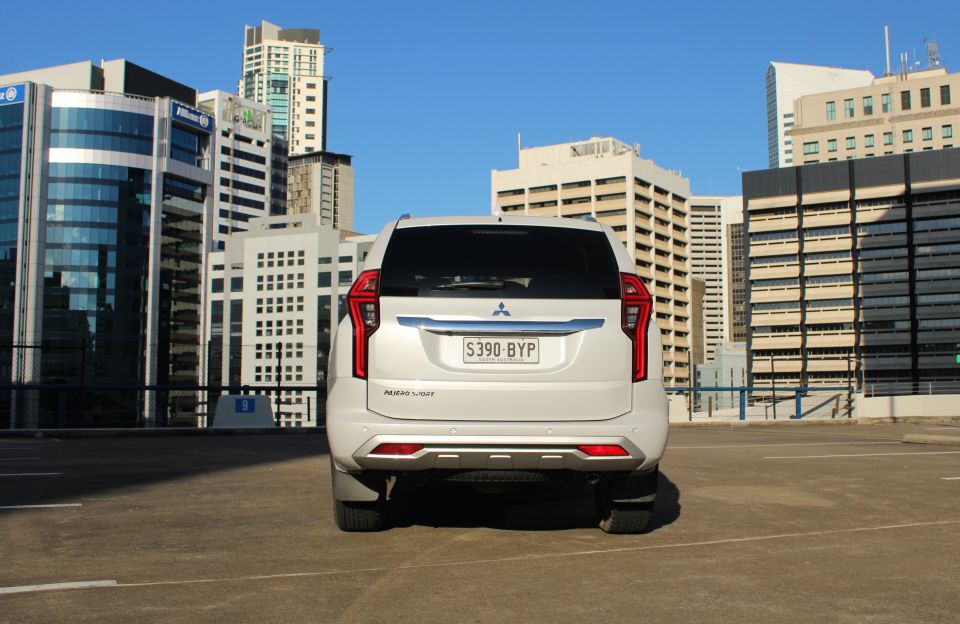
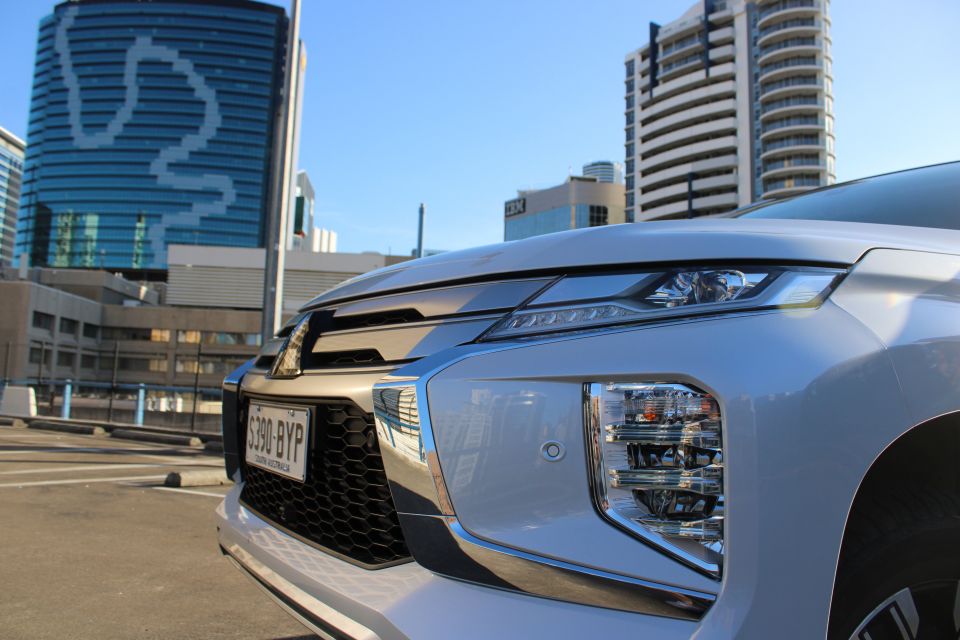
The Exceed does, however, add some important safety features such as blind-spot monitoring, rear cross-traffic alert and a 360-degree camera, while also adding front parking sensors and heated front seats.
It also adds app connectivity. You can download the Mitsubishi Remote Control app, also available for Apple Watch, and use it to check if you’ve left your doors open. You can also turn your lights on and off and check how much fuel you have left.
The LED headlights – standard across the range – are superb and brilliantly illuminate what’s ahead. They feature cornering lights, which are always a welcome addition.
Like the headlights, the front fog lights and daytime running lights use LEDs.
The Pajero Sport is often criticised for its polarising styling, even after a modest facelift this year.
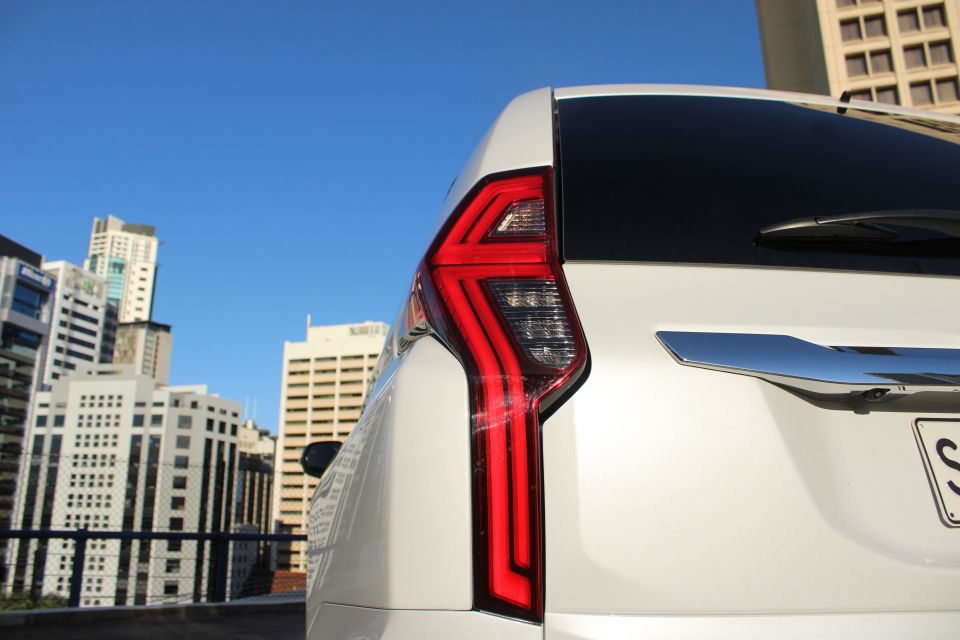
One sticking point for people seems to be the tall taillights.
Personally, I think they’re distinctive and stop the Pajero Sport from looking like a Triton with a shell on the back.
They’re slightly shorter this year, though, which is arguably for the best. Overly vertical tail lights aren’t the best stylistic choice for a ute-based SUV as they accentuate its tall, narrow appearance.
Like an Everest or Fortuner, the Pajero Sport would look vastly better with a wider body and track but, alas, that’s not in the cards.
The Mitsubishi Pajero Sport received a five-star safety rating from ANCAP in 2015, though the independent safety authority didn’t slam one into a barrier.
Instead, ANCAP based the Pajero Sport’s rating off of tests of the related Triton.
The five-star rating was based on a frontal offset score of 15.22 out of 16 and a side impact score of 16 out of 16. Whiplash and pedestrian protection were rated Good and Acceptable, respectively.
For a full breakdown of how ANCAP operates and what the scores entail, check out our feature.
All Pajero Sport models come standard with front, front-side and curtain airbags plus a driver’s knee airbag.
There’s also standard autonomous emergency braking with forward-collision warning and pedestrian detection.
Bizarrely, there’s no lane-departure warning like on the Triton. That also means there’s no lane-keeping assist.
Mitsubishi advertises the Exceed’s standard lane-change assist, but that’s just the name for the audible alert of the blind-spot monitoring system when you’re changing lanes.
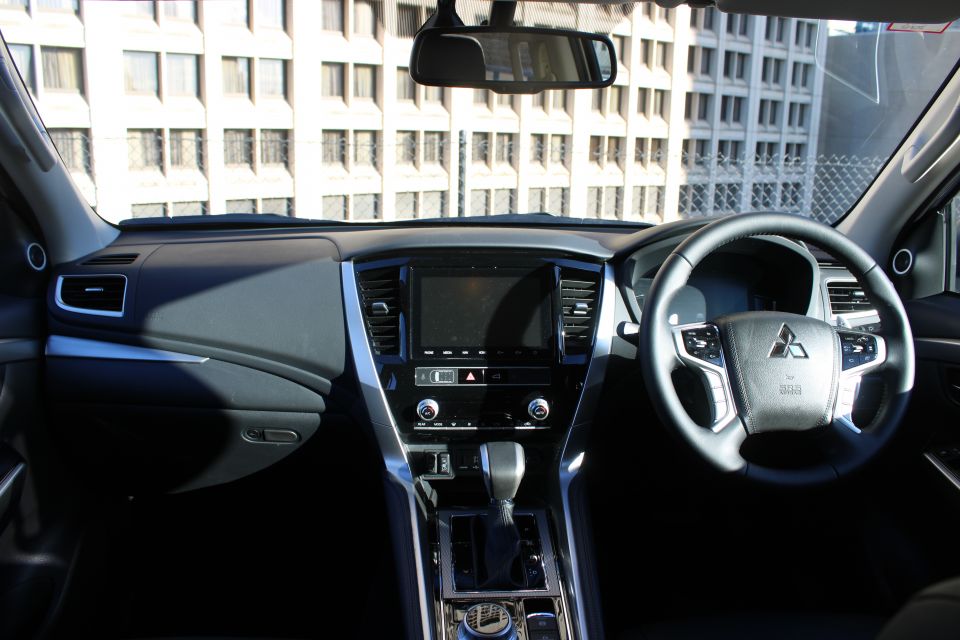
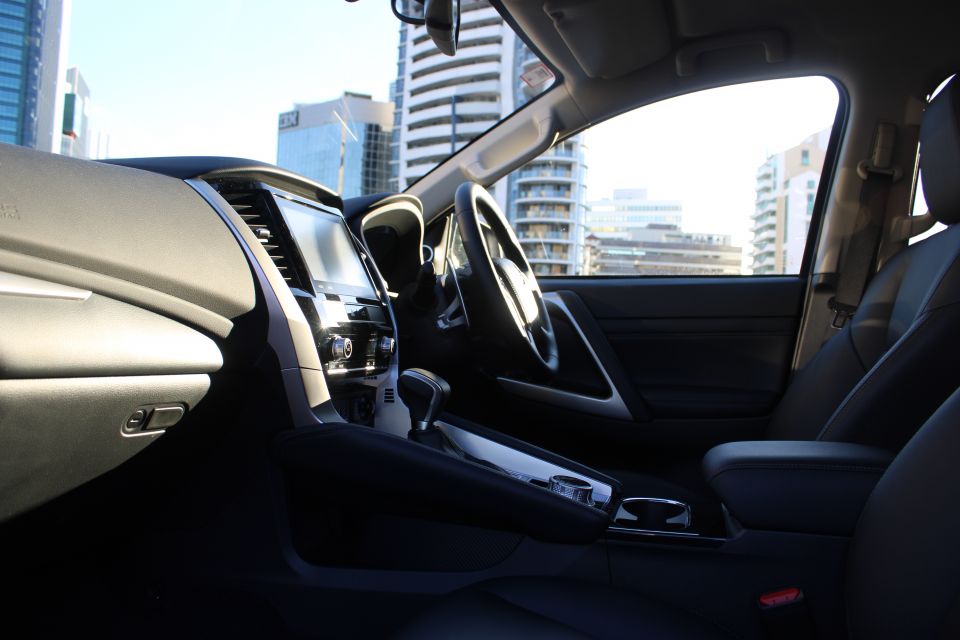
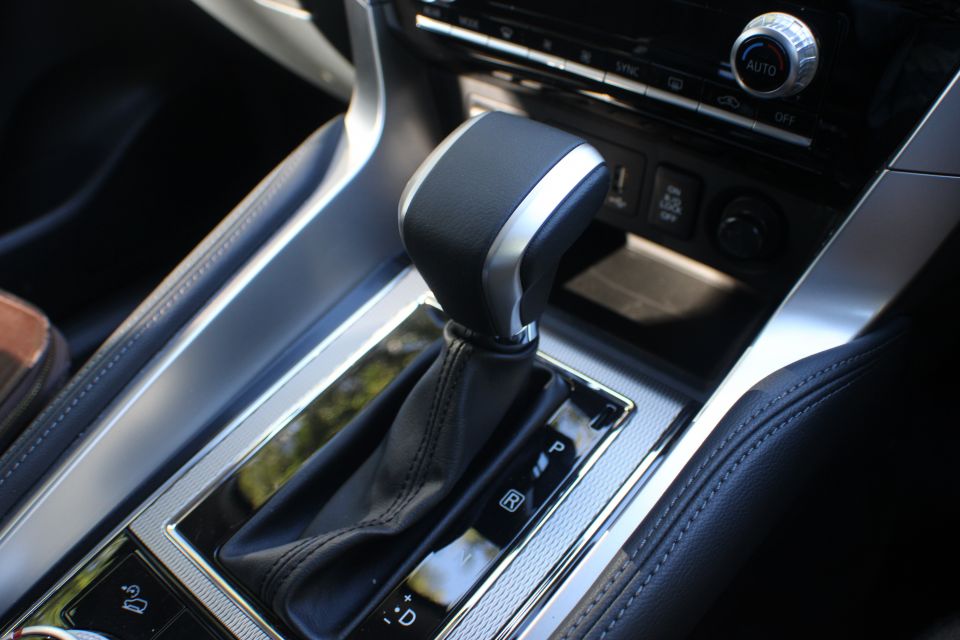

The Pajero Sport interior presents well but, if you look closely, you’ll notice there are plenty of pieces that look awfully similar to those in the Triton.
That includes the hard plastic dash top and door trims. Some of the switchgear is the same, too, as is the retro seatbelt reminder diagram prominently displayed on the dashboard.
However, there are also some touches that markedly elevate the Pajero Sport over its ute cousin.
These include the leatherette trim on the centre console and doors, and the way the centre console rises to meet the centre stack.
The Triton also uses some leatherette down there but overall, the Pajero Sport conveys a more upscale look, helped by the liberal application of silver plastic trim.
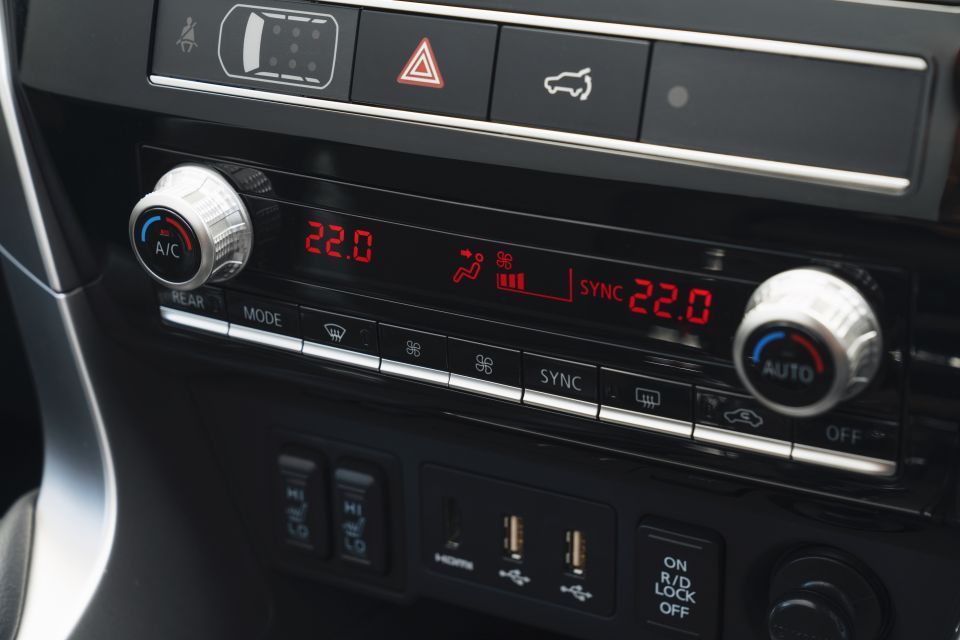
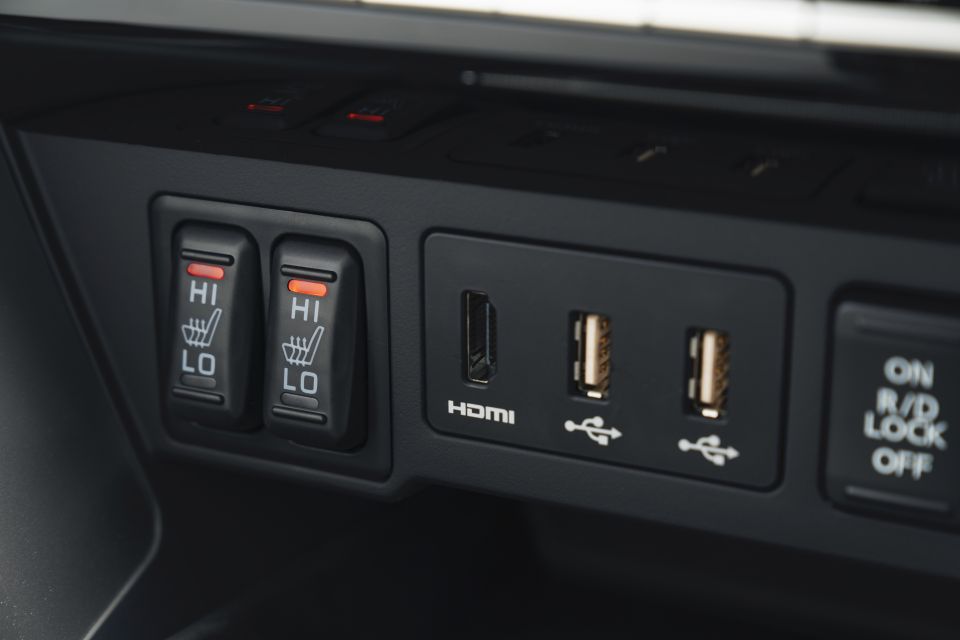
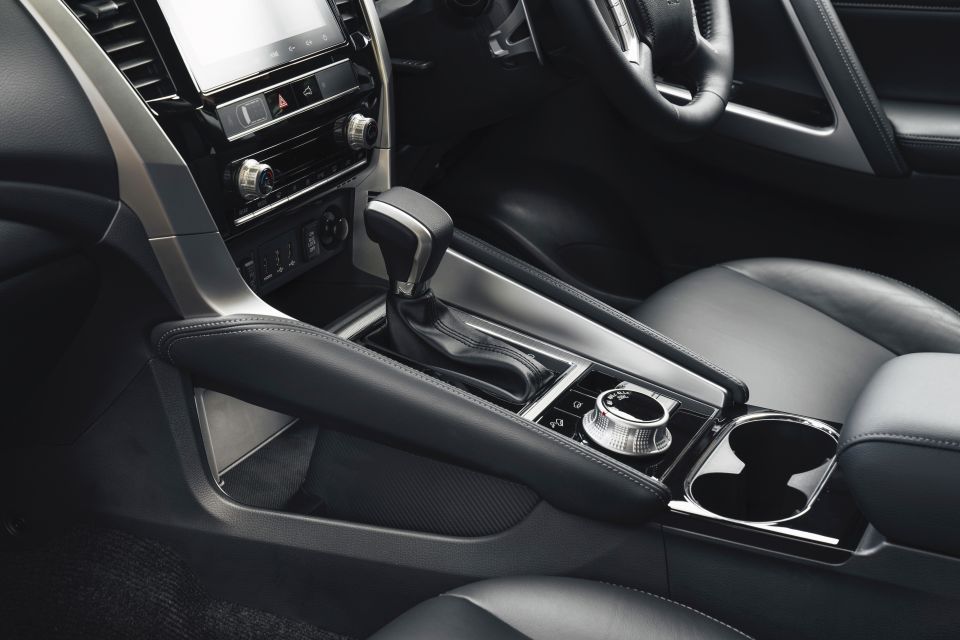
There’s a rubberised shelf just ahead of the shifter which is a good place to put your phone. It’s located just below the heated seat controls, two USB outlets, and an HDMI outlet.
Even more clever is a shelf located underneath the centre console. You might miss it entirely. The doors also have bottle holders that actually fit bottles.
Metallic paddle shifters and fairly tactile switchgear with metallic trim also give the Pajero Sport a boost over its ute cousin.
The most impressive change from the Triton is the 8.0-inch digital instrument cluster, available only on the Exceed. The Pajero Sport GLX and GLS use a carryover instrument cluster from the Triton.
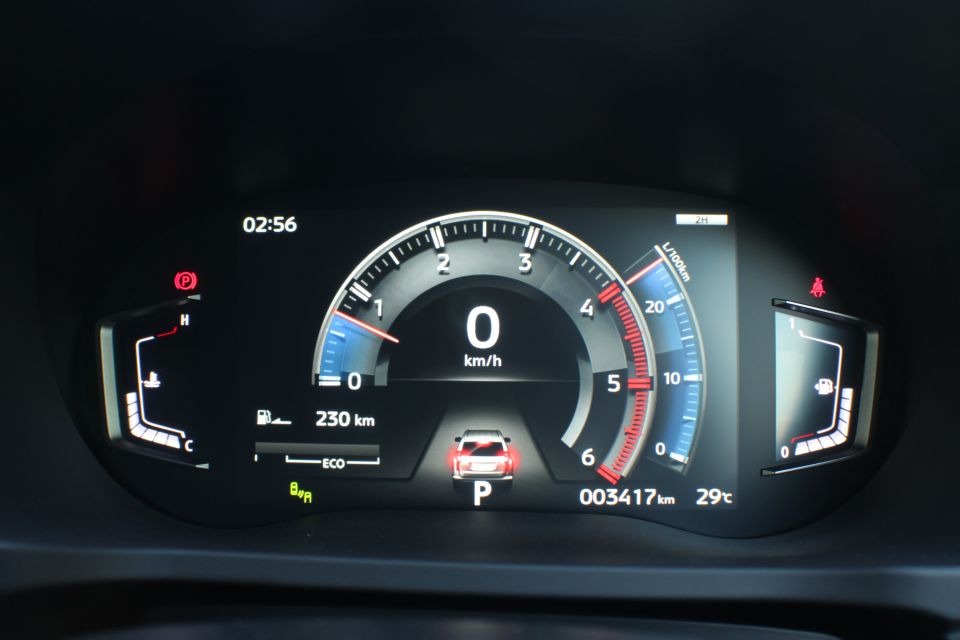
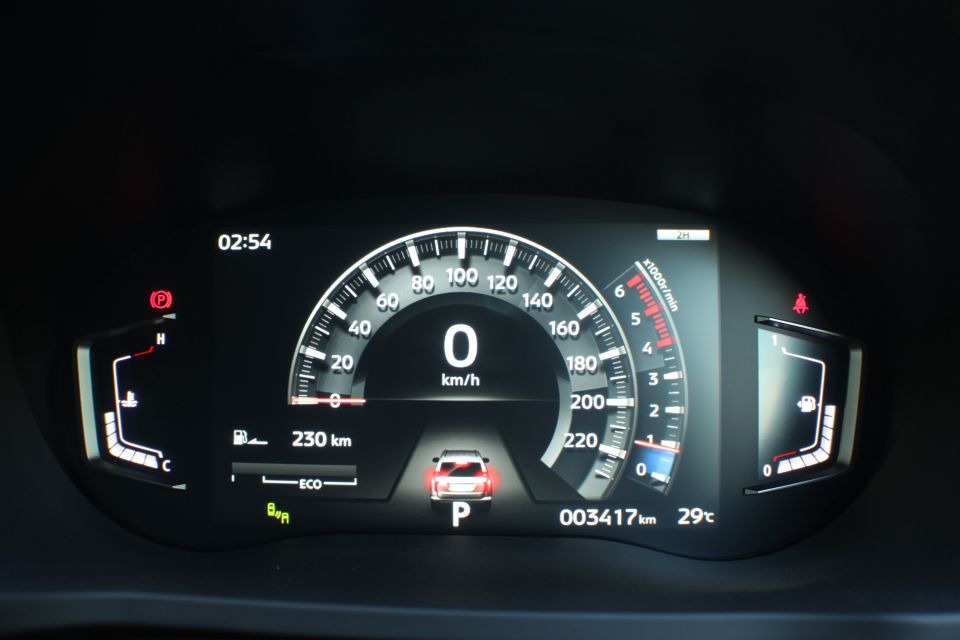
Frankly, the Exceed’s display should be standard across the range. It’s modern and easy to read, and you can toggle between a view that prioritises the speedometer and one that focuses on the tachometer.
Besides, the GLX and GLS’s cluster lacks a digital speedometer, which is a baffling omission in 2020.
Mitsubishi’s dated, unintuitive trip computer has been banished from the Exceed, with a more navigable system employed in the digital cluster.
Also, a cute detail: the brake lights on the little picture of the Pajero Sport illuminate when you brake.
There’s one annoying quirk you’ll notice up front, however: the indicators. Well, perhaps you mightn’t have noticed before but now you will.
The noise they make is irritating, and they sound like a metronome.
You can try to drown out the noise with some music but the sound quality of the eight-speaker audio system is quite flat. It’s an underwhelming system and, surprisingly, an unbranded one. It could be better, especially considering this is a top-of-the-range SUV.
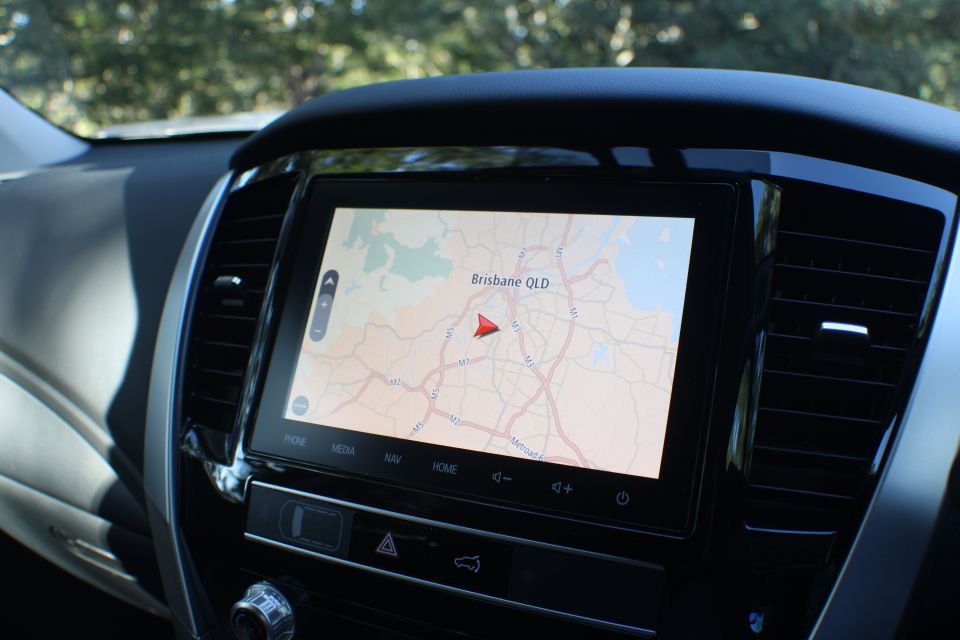
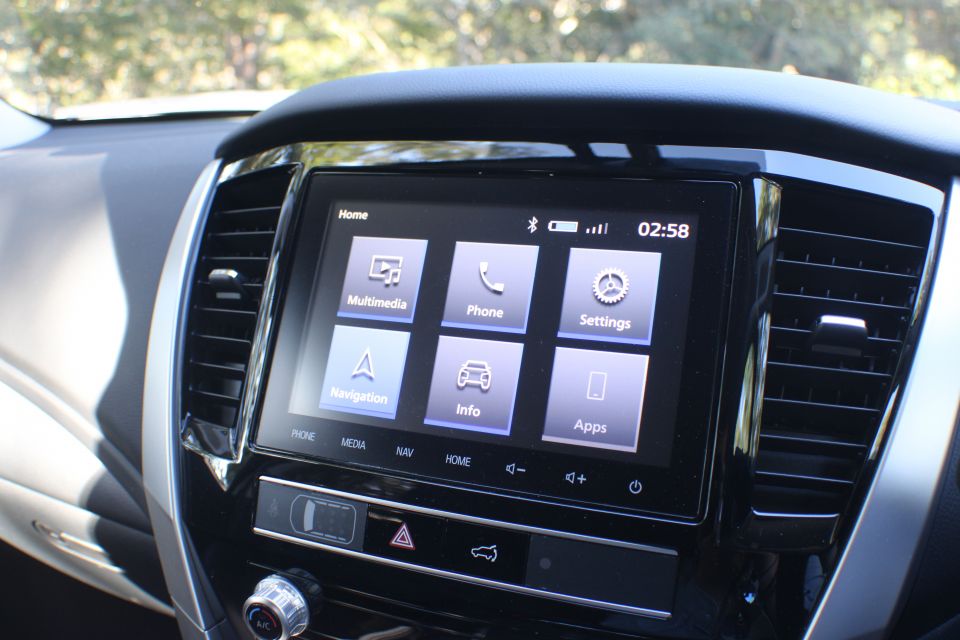
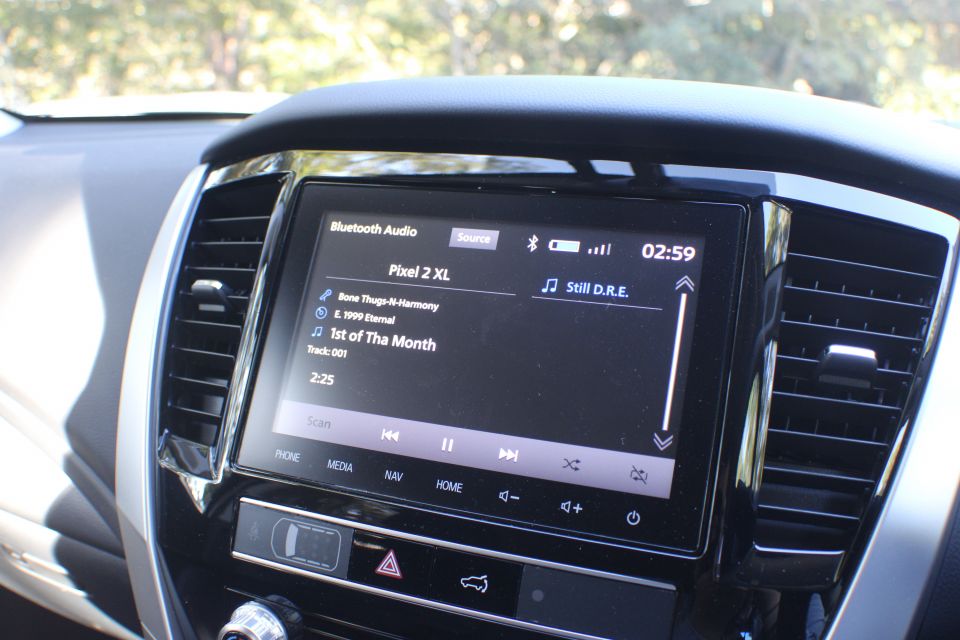
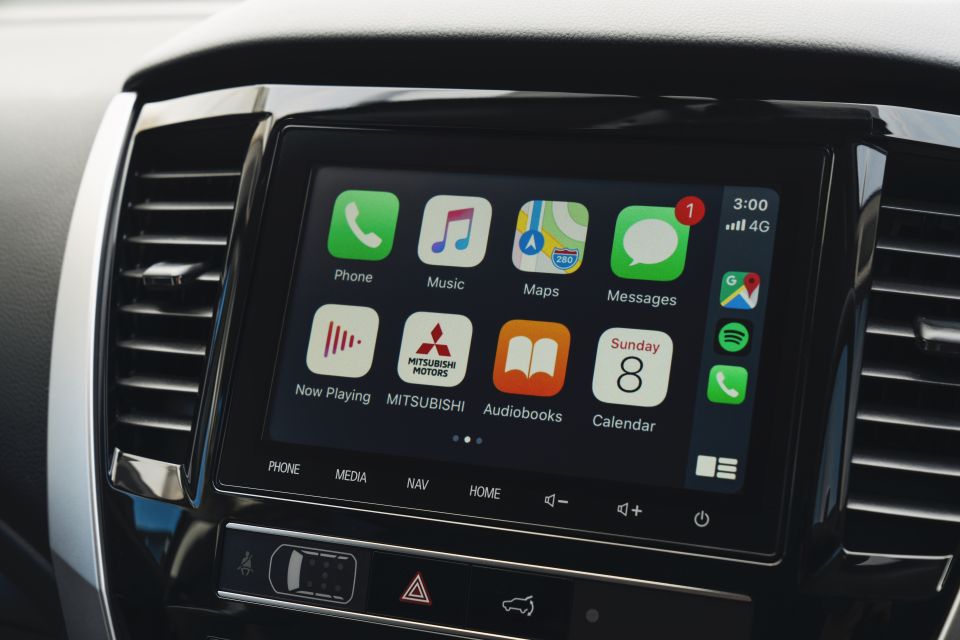
The 8.0-inch touchscreen infotainment system features Android Auto, Apple CarPlay and satellite navigation.
Unfortunately, it’s the same dated navigation system found in other Mitsubishi products.
That means the map is always massively zoomed out when you open the app and doesn’t automatically rotate in the correct direction as Google Maps or many factory navigation units will.
The maps also have poor contrast at night – everything is grey on grey.
One strange quirk can be found on the Pajero Sport’s steering wheel.
The volume and seek/skip track buttons are both on the same side of the steering wheel (logical) but are separated by unrelated buttons (illogical).
You’ll end up changing the appearance of the digital instrument display a few times in error before you memorise which controls are for the audio.
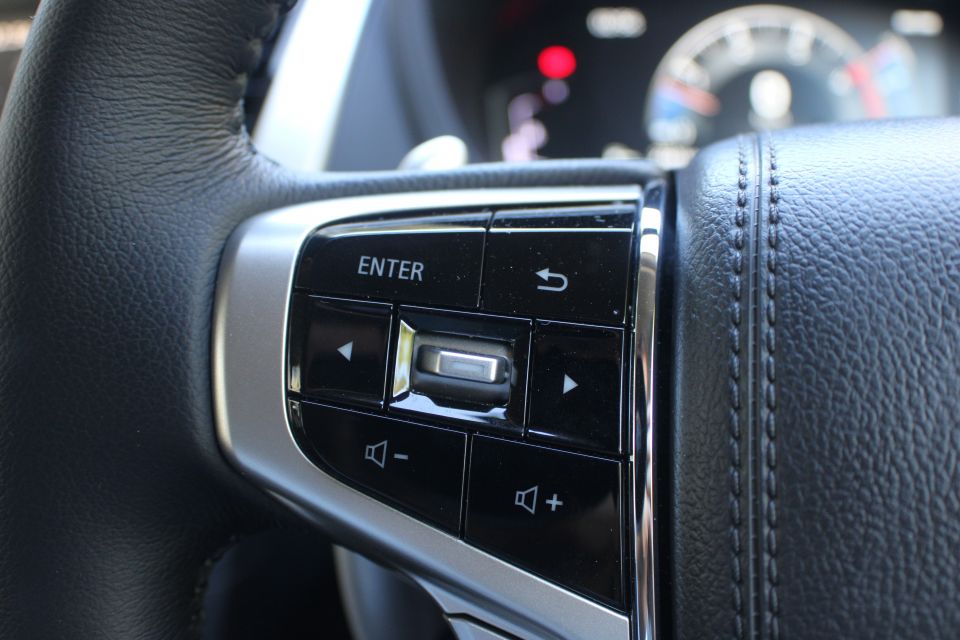

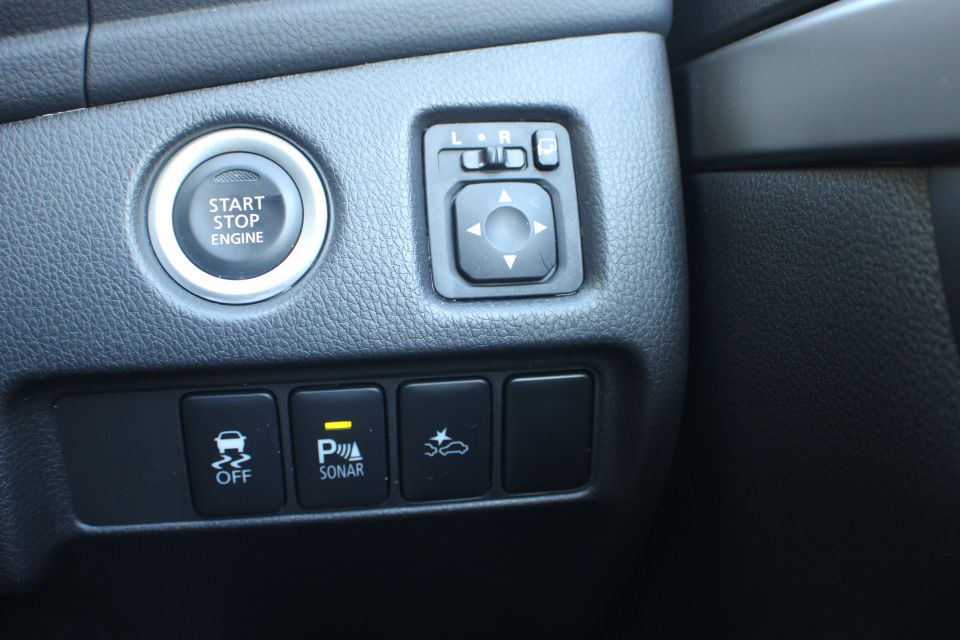
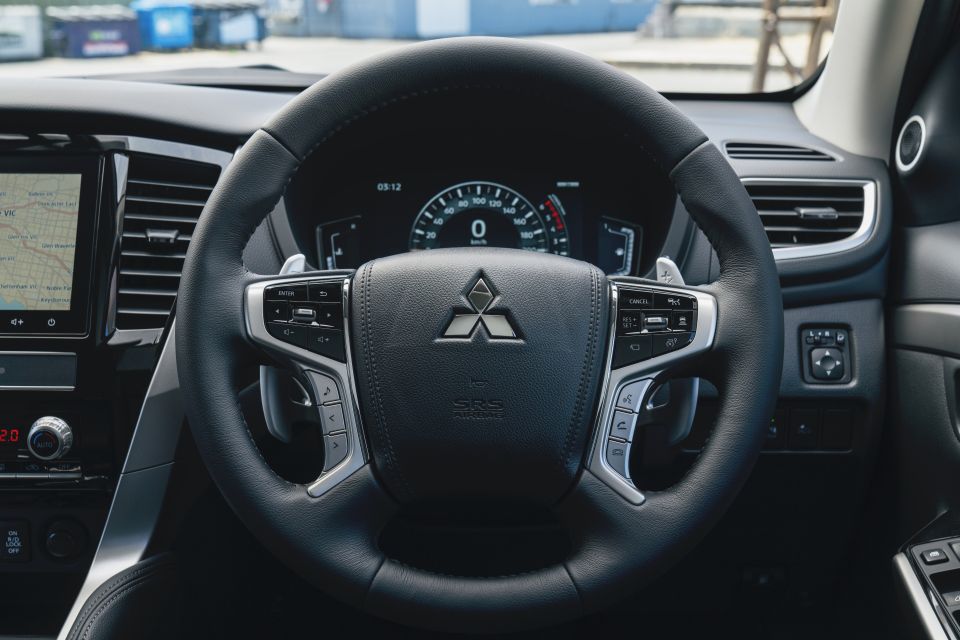
The front seats are plush yet supportive and remain comfortable over long distances. Likewise the second row, where there’s also plenty of legroom.
There are no air vents in the base of the centre console. Instead, there’s a USB outlet and a 220V AC outlet. Air vents can be found on the roof for both second- and third-row occupants.
There are also three top-tether and two ISOFIX anchor points in the second row for child seats.
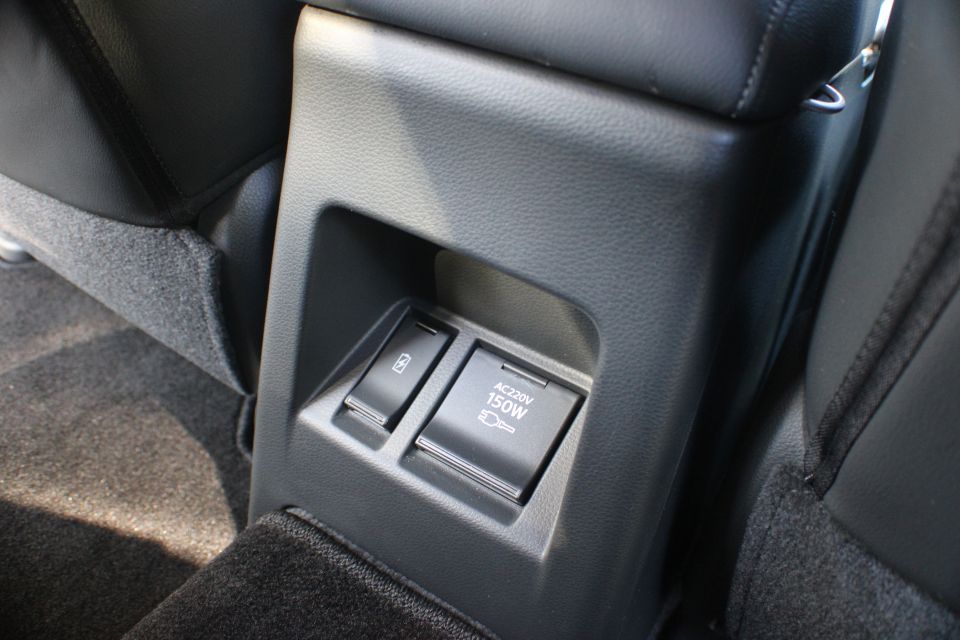
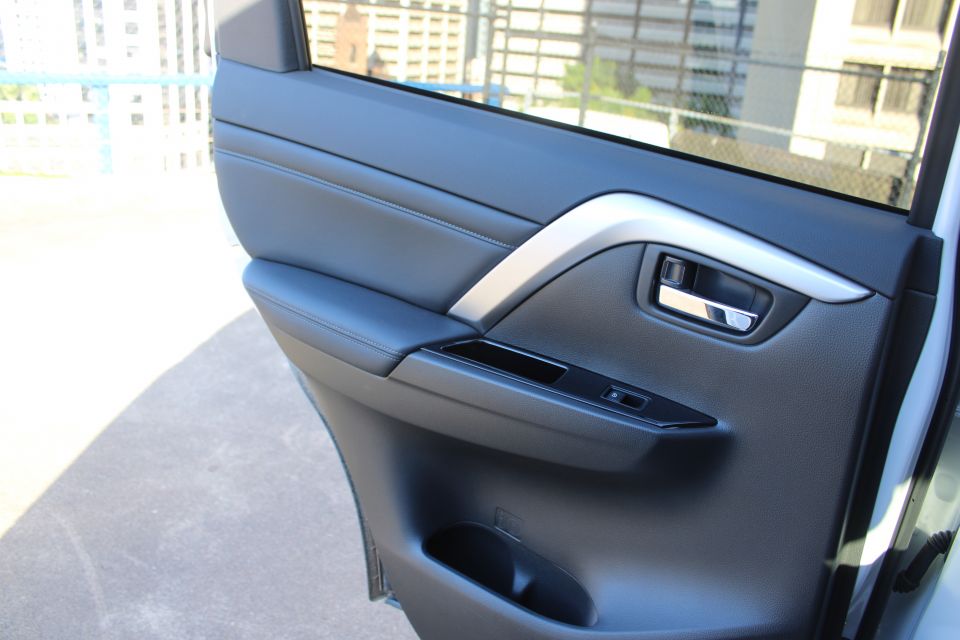

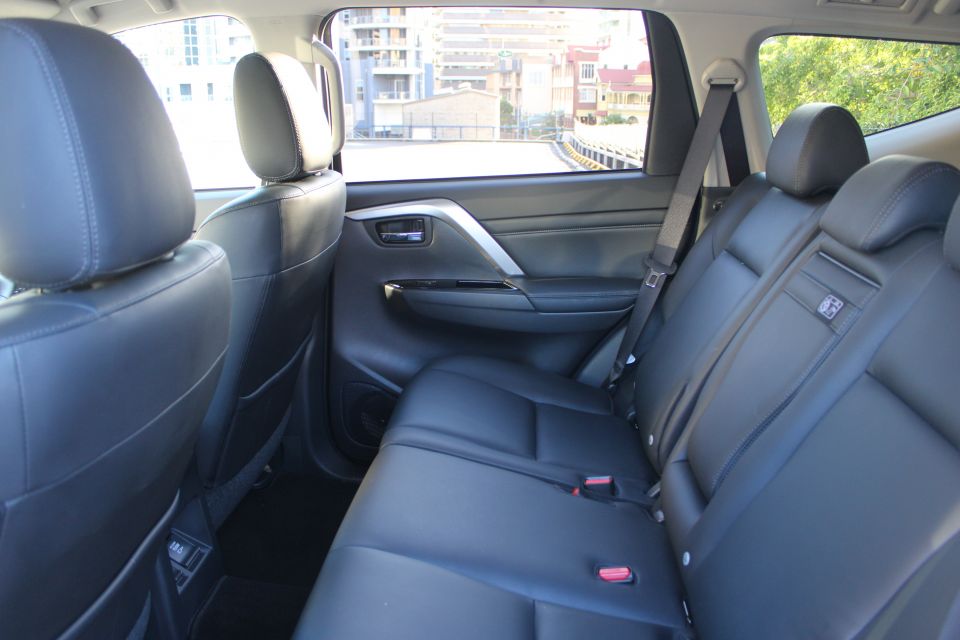

The Pajero Sport’s ute origins are evident as the cabin is narrower than a typical crossover at this price point.
The third row is the most disappointing part of the Pajero Sport’s interior.
To get back there, you need to pull the lever on either side of the second-row seats. They then fold 60:40 up against the front row seatbacks.
Next, you need to awkwardly clamber back into the third row. There’s no graceful way to do this.


For such a boxy, upright SUV, you’d expect third row headroom to be pretty good.
The Pajero Sport is a tight squeeze in terms of both third row legroom and headroom for adults – the seats are clearly designed for use by smaller passengers, and feel dinky.
There are two cupholders back there but they’re both on the driver’s side. A 12V power outlet can also be found in these far reaches of the cabin.
Luggage space is tight with all three rows up, measuring just 131L.
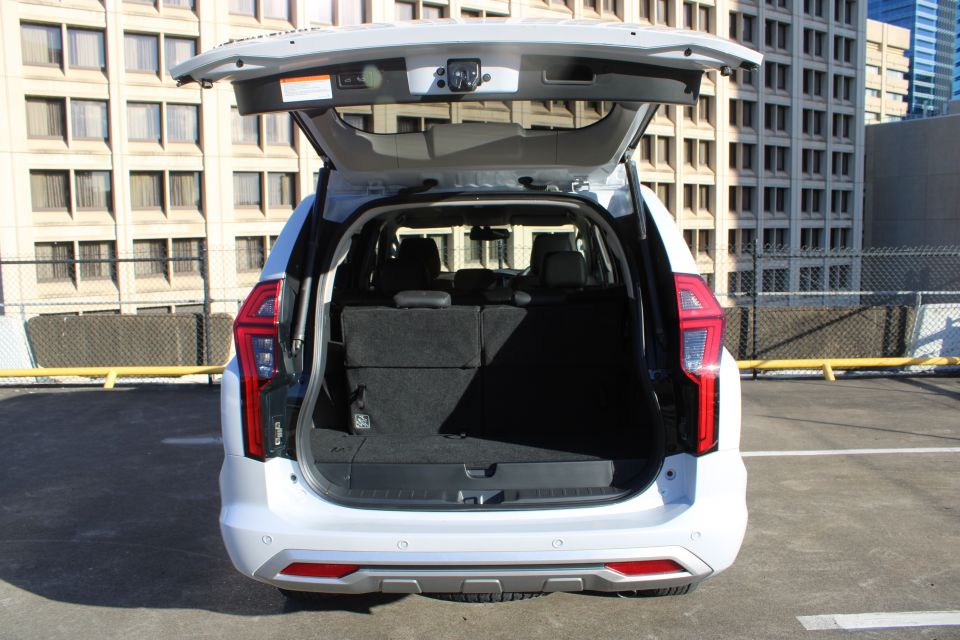
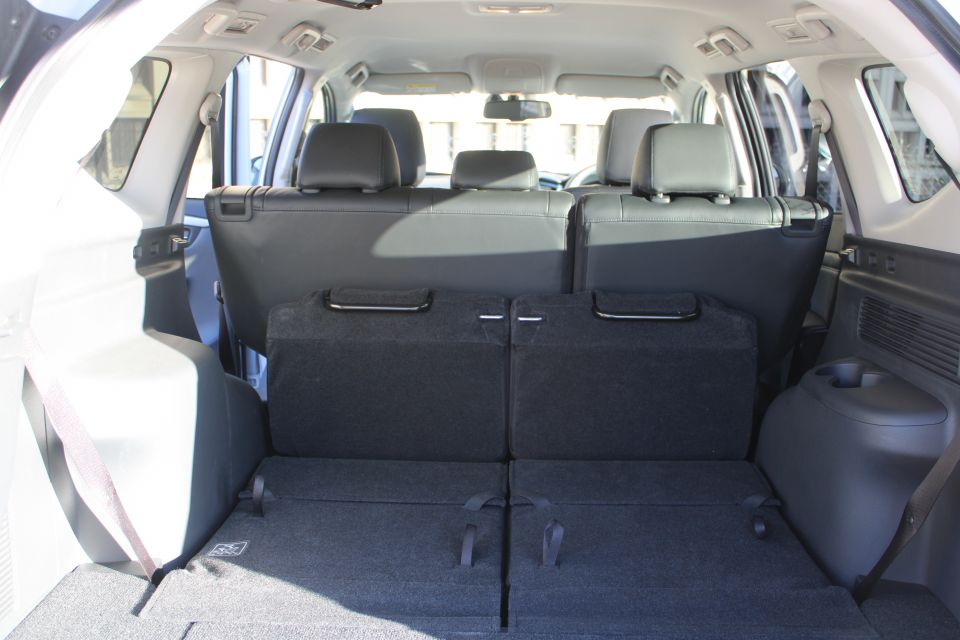
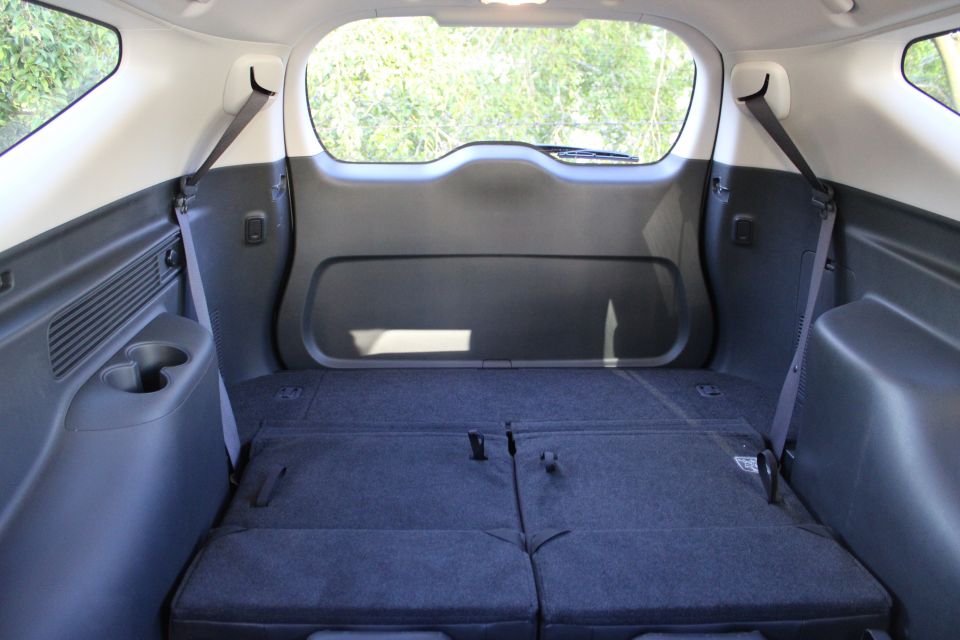
It expands to 502L with the third row folded and a cavernous 1575L with both the second and third row folded.
The second row may sit up against the front seatbacks but the Pajero Sport’s cargo area is otherwise completely flat. The full-size spare is mounted underneath the car.
All Pajero Sport models use a 2.4-litre turbo-diesel four-cylinder engine producing 133kW of power at 3500rpm and 430Nm of torque at 2500rpm, mated to an eight-speed automatic transmission.
Mitsubishi’s Super-Select II four-wheel drive system is standard.
Though it shares its underpinnings with the Triton, the Pajero Sport does a credible job in concealing its ute origins.
Take, for example, the ride quality. It’s vastly superior to the Triton, banishing the jiggly, unsettled feeling of the Triton.
Much of the credit goes to the three-link, coil-spring rear suspension, replacing the leaf springs of the Triton.
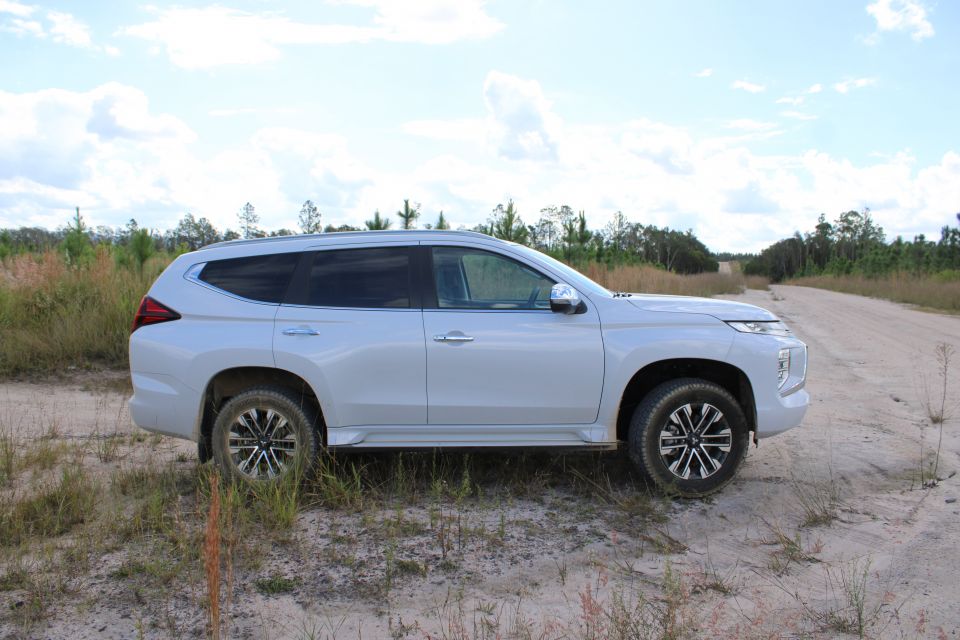

Where expert car reviews meet expert car buying – CarExpert gives you trusted advice, personalised service and real savings on your next new car.
There’s still some impact harshness over sharp ruts but it’s fairly compliant for an SUV with a live rear axle.
Noise suppression is also far superior to the Triton, particularly on the highway. Where the Triton’s engine clatters, the Pajero Sport’s is hushed.
There’s the typical turbo-diesel soundtrack as you punch it from a stop but it never crosses the line into becoming raucous.
It doesn’t cross the line into becoming particularly fast, either, but there’s adequate power to motivate this large SUV. The eight-speed automatic transmission also feels well-matched to the turbo-diesel four.
To drive the Pajero Sport, however, is to understand there are still compromises being made.
While it feels dramatically improved over a Triton, it’s no match for a Hyundai Santa Fe dynamically.
The car-based crossover will run rings around the big Mitsubishi.
The Pajero Sport is 1835mm tall and 4825mm long and, though its steering is decently weighted, this big-boned SUV is resistant to changes in direction.
You’ll want to take corners at the same speed as you would a ute as you can keenly feel the Pajero Sport’s similarly high centre of gravity.
A Santa Fe, in comparison, can be chucked around a sharp turn with ease.
While the Pajero Sport isn’t a match for crossovers on the road, it can go farther off road.
We took our tester on some forestry and national park trails where the Pajero Sport’s 218mm of ground clearance came in handy.
It deftly tackled some heavily rutted, sometimes muddy trails in full-time 4WD (4H) mode, though we didn’t do any serious rock crawling.
It’s safe to say, however, that should it be called upon to attack some truly rough terrain, it’ll be much more capable than a car-based crossover.
You can use the console-mounted dial to toggle between 2H (two-wheel drive) or 4H modes.
There are two other options available. 4HLC is a 4WD high-range mode that locks the centre differential and is best used for off-roading at speeds over 30km/h.
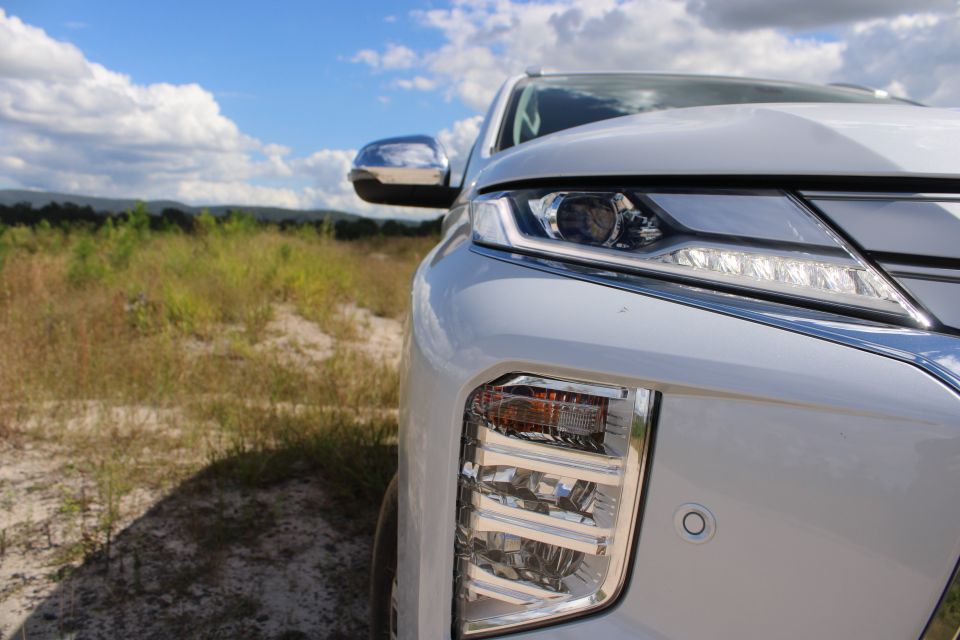
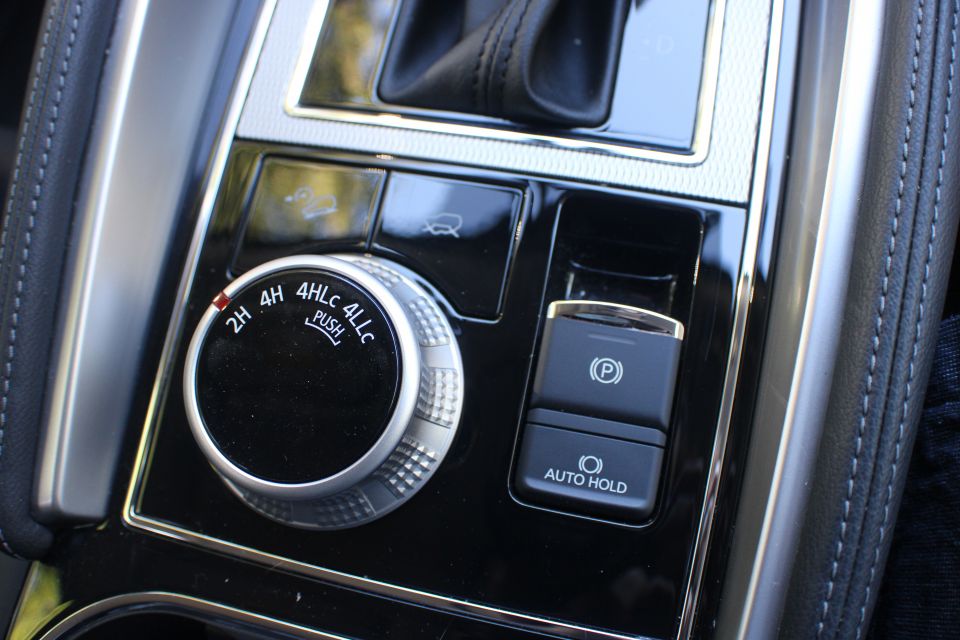
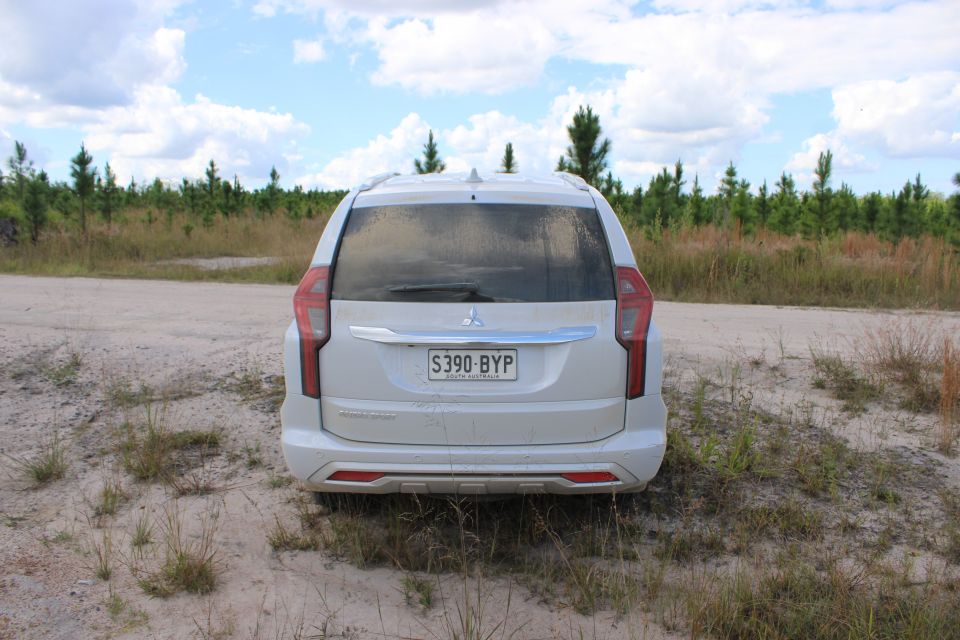

The 4LLC mode also locks the centre differential and shifts the transmission to a lower gear set, for when you want to tackle the really tricky stuff.
There’s also a locking rear differential and specific off-road driving modes for gravel, mud/snow, sand or rocks.
Much as the Pajero Sport bests crossovers off the beaten track, it also bests them with heavy loads.
Towing capacity is 3100kg braked and 750kg unbraked, almost identical to that of a Triton or an Isuzu MU-X or Ford Everest.
Most crossovers top out at 2000kg braked, even if they can match the Pajero Sport’s unbraked figure.
Mitsubishi claims a combined 8.0L/100km on the ADR combined city and highway cycle.
We averaged just over 12L/100km, though that was across a mix of city, highway and off-road driving.
The Pajero Sport requires servicing every 12 months or 15,000km, whichever comes first.
Since 2017, Mitsubishi has offered three years of capped price servicing with the first three services costing $299. The company has also been known to offer a couple of years of free servicing.
Currently, Mitsubishi is offering a seven-year, unlimited-kilometre warranty instead of its usual five-year, 100,000km warranty.
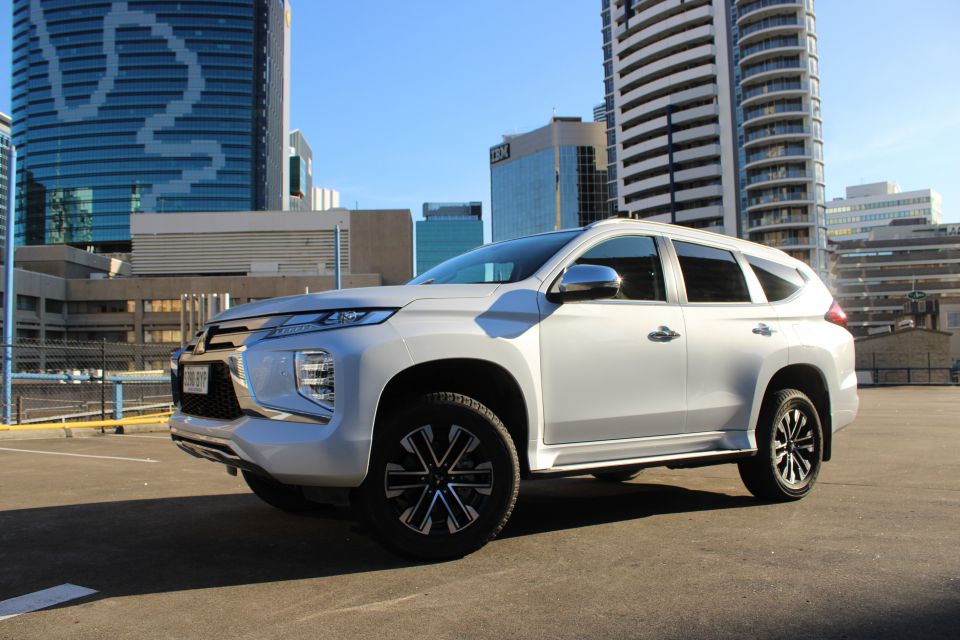
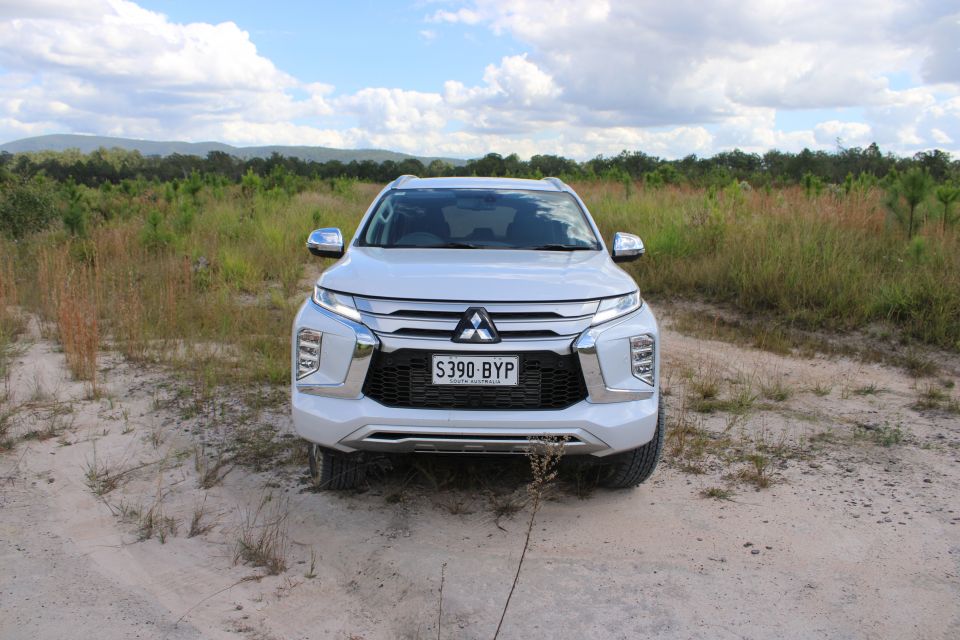
The Pajero Sport may be based on the Triton ute but this isn’t simply a ute with a shell on the back.
Mitsubishi has comprehensively refined the Pajero Sport’s on-road behaviour.
You will, however, feel a difference between this and a car-based crossover SUV like a Santa Fe. Quite simply, you need to evaluate whether you actually need the superior towing and off-road capability the Pajero Sport provides.
If you’re never going to bother taking your SUV off the road, the Pajero Sport isn’t the ideal SUV for you due to its rather cumbersome handling.
It’s also let down by a third row that simply isn’t as comfortable as one might expect from an SUV this size.
The handsome interior could also do with some upgraded materials to truly differentiate it from the Triton.
Nevertheless, if you plan on doing a healthy mix of both on-road and off-road driving, the Pajero Sport represents terrific value.
Where expert car reviews meet expert car buying – CarExpert gives you trusted advice, personalised service and real savings on your next new car.
William Stopford is an automotive journalist based in Brisbane, Australia. William is a Business/Journalism graduate from the Queensland University of Technology who loves to travel, briefly lived in the US, and has a particular interest in the American car industry.


James Wong
5 Days Ago


Max Davies
4 Days Ago


Josh Nevett
3 Days Ago


Josh Nevett
2 Days Ago


Paul Maric
1 Day Ago


Damion Smy
20 Hours Ago